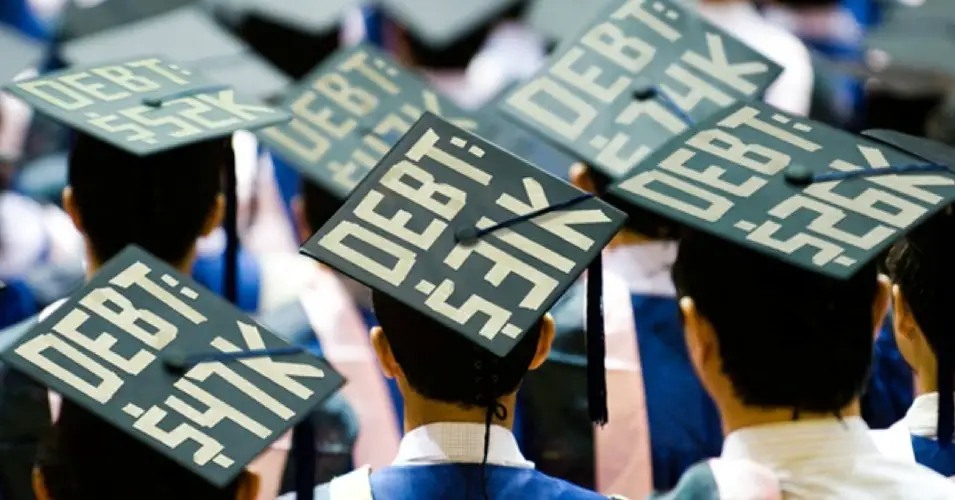In January, The Brookings Institute released a study that is described as the “most comprehensive assessment yet of student debt.” Conducted by Judith Scott-Clayton, the analysis reveals some pretty grim realities, as well as serious implications for the future of college loan default. Studies focused previously on the short-term, which was usually no more than five years after college enrollment.
This time, however, Brookings decided to follow students for 20 years. The best prior estimates indicated that 28–29 percent of all borrowers of college loans would default.
Comparing the 1995-1996 group with the 2003-2004 group, Scott-Clayton believes the new study will provide more insight into student debt than previous studies. Though past research focused on students taking loans during their first semester, the most recent analysis focuses on the cohorts as wholes. Also, the study notes that borrowing rates differ within groups over time.
Findings from the study indicate that college loan default rates continue to rise between 12 and 20 years after enrollment. Rates for the 1995-1996 cohort were around 18 percent at the 12-year mark. Between years 13 and 20, the default rate rose to 26 percent, which was an increase of around 44 percent.
Scott-Clayton notes that even at the 20-year mark, the curve hadn’t leveled off. If studies tracked college loans past 20 years, the default rate would likely continue to rise. For the 2003-2004 cohort, the default rate had already reached 27 percent by year 12. If the previous trend holds true, the 2003-2004 entry cohort could rise to 40 percent within 20 years.
A similar increase seen in the 1995-1996 cohort indicates that 38 percent of the 2003-2004 cohort will default by 2023. Scott-Clayton is careful to note that some factors could influence the growth of default rates within the younger cohort.
Unemployment rates were at their height in 2009-2010, which corresponds to years 6-7 of the 2003-2004 cohort and years 14-15 of the earlier cohort. Additionally, the younger cohort appears to be taking longer to default than the older cohort. Eventually, the younger cohort may experience a greater increase in long-term defaults.
Default rates were nearly four times higher for students attending for-profit colleges and universities than for those attending public institutions. In the 1995-1996 cohort, 23 out of every 100 students who attended a for-profit school defaulted on their loans within 12 years of enrollment. Data suggests that the default rates for 2003 cohort students who’ve attended for-profit schools could end up near 70 percent at the 20-year mark. Researchers removed for-profit college loan default increases from the equation. They were much more modest at 3 percent overall and 8 percent among black students.
Unfortunately, the findings are even more staggering for black students. Scott-Clayton states that debt and default levels for black recipients of college loans are at “crisis levels.” Even a bachelor’s degree may not be able to help with the situation.
In fact, the study found that nearly 38 percent of black college students have defaulted within 12 years of enrollment. The figure indicates a rate of default that is more than three times that of their white counterparts. It’s also 13 percent higher than black students in the cohort eight years earlier. Data suggests that 70 percent of black students with college loan debt may eventually default.

Unlike other demographics, black students may default on student loans, even if they aren’t in the drop-out or for-profit populations. The study also discovered that black bachelor’s students are five times more likely to default than white students.
The rate is a reflection of higher levels of borrowing for graduate school combined with lower rates of repayment. The evidence ultimately concludes that poorer labor-market outcomes and graduate-level enrollment in for-profit schools contribute to the high rates of default seen in this demographic.
Interestingly, the research concluded that default rates for college loans were higher among those who borrowed smaller amounts of money. Roughly 37 percent of students who borrowed between $1 and $6125 defaulted within 12 years. Only 24 percent of those who borrowed $24,000 or more did the same. Defaults among drop-outs have risen most rapidly at 24 percent; however, default rates are actually at 28 percent among students who have post-secondary or graduate certificates.
Roughly 70 percent of graduates leave college with debt; strikingly, 44 million Americans hold an astonishing total of $1.4 trillion of student debt. At its current level, student debt is now one of the largest sources of household debt, second only to mortgages. Student loans are the only form of consumer debt that continued to grow during the Great Recession.
The increase in debt, however, owes more to the higher college enrollment than to individual debt levels. While the expectation for repayment of college loans is 10 years, it will take twice as long for many people. About 60 percent of college loan borrowers expect to pay off their debt by their 40s, over 20 years after their first semester of college. Similarly, another study from One Wisconsin Institute found that loan repayment takes 19.7 years for bachelor’s degrees and 23 years for graduate degrees.
According to the Federal Reserve, 6.8 million student loan recipients are in their 40s and hold a collective debt of about $230 billion. Each debt holder owes an average of about $34,000. The Federal Reserve also discovered that increasing student debt corresponds to a decrease in home ownership. Another bewildering study, which was conducted by NerdWallet, predicts that 2015 graduates will need to delay their retirement until the age of 75, partially due to the burden of college loans.
Students eyeing college loans have serious considerations to keep in mind when making their final decisions. They need to consider how long it will take to repay their loans. By researching their future income and the cost of their studies, they can make an estimate. People should make final decisions after considering potential future expenses, such as mortgages and families.
Eventually, researchers may use careful scrutiny to resolve problems surrounding student loan debt. Until then, students will have to plan carefully for their continuing education to accomplish their ambitions without too much debt.

















